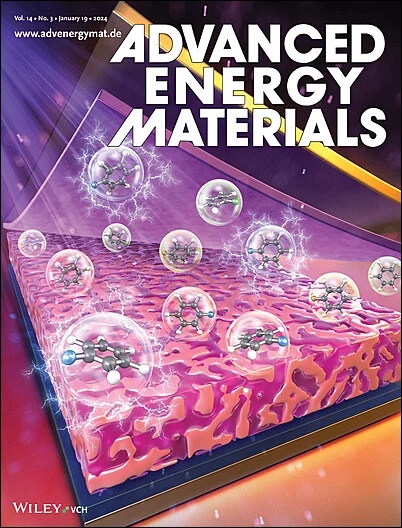Improved Performance and Stability of Perovskite Solar Cells by Incorporating Silicon Quantum Dots within the FAPbI3 Active Layer
IF 26
1区 材料科学
Q1 CHEMISTRY, PHYSICAL
引用次数: 0
Abstract
Embedding inorganic quantum dots (iQDs) within the perovskite absorber offers a promising route to improve both efficiency and stability in perovskite solar cells (PSCs). Due to the defect‐tolerant nature of lead halide perovskites, iQDs can be incorporated within crystal grains without degrading performance, while contributing their unique optoelectronic properties. In this study, silicon quantum dots (SiQDs) are embedded into perovskite films to form high‐quality hybrid thin films. Prior to forming the hybrid film, a femtosecond laser‐based surface engineering (SE) technique is used to fragment SiQDs into highly dispersed, stable, ultrasmall particles (≈2 nm). Incorporation of SE‐treated SiQDs (SE‐SiQDs) into the perovskite layer reduces the density of shallow traps and improves carrier transport. A substantial decrease in residual lead iodide (PbI在FAPbI3活性层中加入硅量子点提高钙钛矿太阳能电池的性能和稳定性
在钙钛矿吸收剂内嵌入无机量子点(iQDs)为提高钙钛矿太阳能电池(PSCs)的效率和稳定性提供了一条有前途的途径。由于卤化铅钙钛矿的耐缺陷特性,iqd可以集成在晶粒中而不会降低性能,同时贡献其独特的光电性能。在这项研究中,硅量子点(SiQDs)嵌入到钙钛矿薄膜中,形成高质量的混合薄膜。在形成杂化膜之前,利用飞秒激光表面工程(SE)技术将SiQDs分割成高度分散、稳定的超小颗粒(≈2 nm)。将SE处理的SiQDs (SE - SiQDs)掺入钙钛矿层中可以降低浅阱的密度并改善载流子的输运。在薄膜表面观察到残留碘化铅(PbI2)的大量减少,并且通过SiQD的掺入实现了费米能级的调制。含有SE - siqd的psc具有超过80%的填充因子和超过20%的功率转换效率(有效面积:0.23 cm2),以及增强的长期运行稳定性。
本文章由计算机程序翻译,如有差异,请以英文原文为准。
求助全文
约1分钟内获得全文
求助全文
来源期刊

Advanced Energy Materials
CHEMISTRY, PHYSICAL-ENERGY & FUELS
CiteScore
41.90
自引率
4.00%
发文量
889
审稿时长
1.4 months
期刊介绍:
Established in 2011, Advanced Energy Materials is an international, interdisciplinary, English-language journal that focuses on materials used in energy harvesting, conversion, and storage. It is regarded as a top-quality journal alongside Advanced Materials, Advanced Functional Materials, and Small.
With a 2022 Impact Factor of 27.8, Advanced Energy Materials is considered a prime source for the best energy-related research. The journal covers a wide range of topics in energy-related research, including organic and inorganic photovoltaics, batteries and supercapacitors, fuel cells, hydrogen generation and storage, thermoelectrics, water splitting and photocatalysis, solar fuels and thermosolar power, magnetocalorics, and piezoelectronics.
The readership of Advanced Energy Materials includes materials scientists, chemists, physicists, and engineers in both academia and industry. The journal is indexed in various databases and collections, such as Advanced Technologies & Aerospace Database, FIZ Karlsruhe, INSPEC (IET), Science Citation Index Expanded, Technology Collection, and Web of Science, among others.
 求助内容:
求助内容: 应助结果提醒方式:
应助结果提醒方式:


